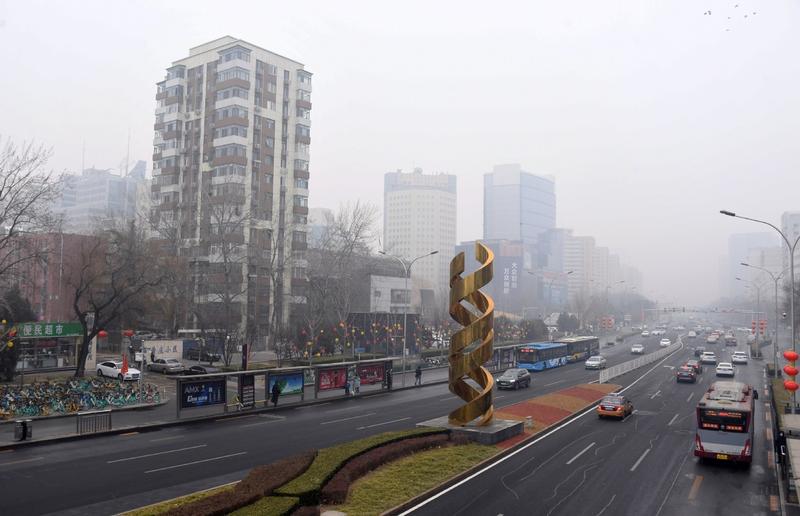 Heavy smog blankets Beijing, on Feb 13, 2021. (PHOTO / XINHUA)
Heavy smog blankets Beijing, on Feb 13, 2021. (PHOTO / XINHUA)
Heavy air pollution that began on Tuesday is expected to continue blanketing North and Northeast China until Monday, when a cold air mass will arrive to disperse it, monitoring centers said.
As for Beijing, the center attributed 65% of the pollution to transmission from other areas and 35% to local emissions
The latest round of pollution has triggered heavy air pollution alerts in 39 cities in provinces including Liaoning, Hebei, Henan and Shandong.
Affected by southerly winds, air pollution that started in Central China's Henan province moved northward and has been hovering between the Taihang and Yanshan mountains, where Beijing and surrounding cities are located, the Chinese Research Academy of Environmental Sciences' National Joint Research Center for Tackling Key Problems in Air Pollution Control said.
By Thursday, daily peak PM2.5 readings in 10 cities in the Beijing-Tianjin-Hebei cluster and northeastern provinces had hit an average 191 micrograms per cubic meter, while the national standard for good air quality stands at an average 75 mg per cu m in a 24-hour period. The smog reduced visibility in the capital to 1 kilometer, the Beijing Meteorological Service said.
ALSO READ: More incentives urged to tackle pollution
High humidity and surface inversion, a condition that sees air temperature increase with height above ground level, caused unfavorable weather for dispersing pollutants. Less wind at the base of the two mountain ranges kept the pollution in the area, the center said.
In recent years, the number of heavy pollution days in March has been between four and eight days, while in 2019 it was two, Wang Shuxiao, an environment professor at Tsinghua University, told Beijing Daily.
Starting from Monday, cold air in northern areas will facilitate dispersal and help ease the pollution, monitoring centers in Beijing and northeastern China said.
Emissions from industrial plants, vehicles and spring farming were to blame, the national joint research center said.
The resumption of social activities and production after the Spring Festival holiday in February increased pollutants.
Satellite monitoring from March 8 to 10 showed that the number of spots where people burned straw for fertilizer in Henan and Shandong provinces increased tenfold over the previous week.
As for Beijing, the center attributed 65 percent of the pollution to transmission from other areas and 35 percent to local emissions.
The center suggested that local governments should require enterprises to take emergency measures to reduce emissions.
The capital's environmental and police authorities have launched a campaign to check areas with high emissions, and officers have fined the owners of more than 400 diesel vehicles that discharged excessive pollutants.
READ MORE: China realized fewer days of air pollution
Beijing environmental authorities also required about 200 stationary pollution sources, including boilers and chemical plants, to make rectifications to reduce emissions.
Beijing's municipal law-enforcement bureau suspended the operation of some construction sites and asked them to use sprinklers to keep dust from the air during days with heavy pollution. Officers also patrolled the city to prevent people lighting outdoor fires and barbecues.


